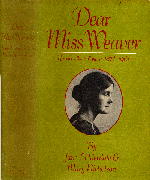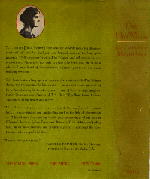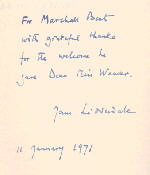Jane received an Honours Degree in Politics, Philosophy and Economics at the Society for Home Students (later St. Anne's College), Oxford. Following graduation Jane became Sub-editor of the Journal of the Royal Institute of British Architects, when E.J. Carter was editor. This work was cut short by the outbreak of war in 1939 and she then joined the Ministry of Shipping (afterwards War Transport) as a temporary administrative Officer with the rank of Assistant Principal. Later she was promoted to Principal.
Of her success in the Ministry this anecdote may amuse the reader. It was written by Eric Lidderdale to his uncle Hector, Eric never having seen Jane.
"Two very senior officials of the War Transport dined with me last night (Calcutta, 2-4th May 1945) and talked with unstinted praise of one Jane L. They were amazed I should not know such a beautiful, talented member of the clan. Can you help? After all that I heard I feel that one of my first duties on my next visit home should be to meet her. They more or less implied that the only reason that the troops got any supplies was because of Jane. They also said that she had been offered a permanent post in the Civil Service."
Her experience in the Planning Section of the Allocation of Tonnage Division (by then a temporary Principal) led to her transfer in 1946 to the Office of the Lord President of the Council, then Herbert Morrison. He had been asked by the Labour P.M., Clement Attlee, to think out how best to get the country on its feet again and was gathering round him a few Administrative Class Civil Servants with planning experience. Jane was the most junior. Varied and fascinating work, much of it done as secretary or joint secretary of several Cabinet Committees.
While at the Office, during the fuel crisis of the severe winter of 1946-1947 Jane had the privilege, unusual for a woman, of sharing with the Secretary of the Cabinet, Sir Norman Brook, the Secretaryship of the Prime Minister's Fuel Committee. Later she was appointed by the Prime Minister Secretary of the Committee of Enquiry into the law and practice relating to Charitable Trusts (the Nathan Report on Trust Law).
She again worked with Herbert Morrison on the organization of the Festival of Britain, which took place in 1951. For this work she was awarded the OBE in 1952. She was appointed secretary and head reseracher for the Nathan Report on Trust Law in 1952 before leaving the Civil Service the next year. From 1953-1960 she undertook commissioned enquiries into the education and employment of graduates, and two reports on employment and, later, one on education followed.
Since then she has gave most of her time to voluntary work in Kensington. Jane joined the council of management of the Byham Shaw School of Art in 1961, and became its chairman in 1970. In 1963 founded and became chairman of The Kensington Day Centre for frail old people. Only in 1988, at the age of 79, did she resign from these Chairmanships.
In 1970 Faber published Dear Miss Weaver, a biography, written with a friend, Mary Nicholson, of her godmother, Harriet Weaver, the patroness of James Joyce. Jane was also guardian (1962-1982) of his schizophrenic daughter, Lucia, succeeding her godmother.
Reprinted from:
- Lidderdale, Robert Halliday, An Account of the Lowland Scots Family of Lidderdale, 1950 unpublished manuscript.
- Lidderdale, Halliday Adair, The Descendants of John Lidderdale 1783-1845, 1988 unpublished manuscript.
Jane Lidderdale was brought up in Hampstead, England, and was graduated from Oxford in 1934. In 1952 she was appointed an officer of the Order of the British Empire (O.B.E.) for work done in the Civil Service. A London resident for the past thirty years, she spent eight of them writing and researching of this biography. She confesses that ne of her more special skills is "playing patience." Even so, when other commitments threatened to hold up the book, she enlisted the aid of her friend, mary (Crawford) Nicholson, a novelist and teacher.
Reprinted from flyleaf of her book, Dear Miss Weaver, Harriet Shaw Weaver 1876 - 1961, published by the Viking Press in 1970.
Click on each picture below for a larger version.
 |
 |
 |
| Front cover of Dear Miss Weaver |
Rear cover of Dear Miss Weaver |
Inscription from Jane Lidderdale to
Marshall Best, Viking's editor-in-chief |
Papers collected by Jane Lidderdale during her work on the biography of Harriet Shaw Weaver and letters from Lucia Joyce are maintained in the James Joyce Collection at the University College London (http://www.ucl.ac.uk/Library/special-coll/joyce.htm).
The papers of Jane Lidderdale, 1962 - 1969, comprising her correspondence with Margaret Storm Jameson and Rebecca West regarding Jane's memoir of Harriet Shaw Weaver are held at Women's Library, London (reference GB 0106 7/JLI) (http://www.aim25.ac.uk/).
Jane H. Lidderdale was Secretary to the British Association Study group on "The Education of the Graduate Scientist in School and University," sponsored by The British Association, supported by the Leverhulme Trust. Papers are held by London University, Imperial College Archives: Papers of Sir Patrick Linstead CBE FRS (1902-1966). (http://www.Ancestry.com).
Obituary for Jane Hester Lidderdale, by Angus Stirling, The Independent, London, U.K., Oct 7, 1996, p. 20.
In appearance and in life, Jane Lidderdale epitomised the English virtue of understatement.
From her mother she inherited a strong Protestant attachment to work and philanthropy; from her grandfather, the painter C.S. Lidderdale, came her lifelong affiliation to the arts. These were the guiding strands in her many-sided interests and activities.
In the first part of her career, after leaving Oxford with an Honours degree in PPE, Lidderdale was able to realise her exceptional talent for organisation and research through a variety of posts in the Civil Service. She joined the Ministry of Shipping in 1940 and was secretary to a number of cabinet committees during the Second World War, and immediately afterwards to the Fuel Committee in the winter of 1946-47, one of the hardest of the century.
During the post-war Attlee government she worked especially closely with Herbert Morrison, and she played a leading role in organising the Festival of Britain in 1951. She was secretary and chief researcher for the Nathan Report on Trust Law at that time, and even after leaving the Civil Service in 1953 she continued to carry out research for a variety of official and semi-official inquiries, particularly concerned with education and employment.
The pattern of her life thereafter was to prove Jane Lidderdale's talent not only for organisation, but for far-sighted leadership and a determined resolve to set goals for herself and others, and then to achieve them. In this respect she had some of the characteristics of a renowned philanthropist of an earlier generation, Octavia Hill.
Lidderdale came to know Rachel Alexander of Aubrey House, Kensington, and together they opened Ray House, a residential home for elderly ladies. But after visiting one of Britain's first Day Centres, in Camberwell, south-east London. Lidderdale decided that there should be a similar place in North Kensington where frail elderly people could have a degree of care, enjoy company and share in activities, thus avoiding the need to leave their homes for an institutionalised ending to their lives. She found a site and, using her formidable range of contacts and skills of persuasion, raised the pounds 40,000 needed to build the centre she envisaged. Lidderdale became the founding Chairman of the Kensington Day Centre in 1963 and remained so until 1988. It was her devotion, interest and diplomacy that gave the centre the secure foundation and excellent relationship with the Royal Borough which continues today.
In the midst of this work Lidderdale became interested in the Byam Shaw School of Painting and Drawing (as it was then called), a few doors away from her home in Campden Street.
She was elected to its Council of Management in 1961 and nine years later became Chairman. The Byam Shaw derived its strength as a fine art school from its independence from the state system. Throughout the 18 years of her distinguished chairmanship Lidderdale was adept at preserving that independence in the context of a constantly fluctuating art education scene; she ensured that the school's Diploma retained its high reputation and status, and among many changes she guided the school through its move in the 1980s from Kensington to Archway in north London.
Jane Lidderdale made an art of chairmanship. The least flamboyant of figures, always soberly dressed and restrained in manner, she made up in the authority of her bearing for her modest stature. She was a stickler for detail. Possessed of great precision of mind, she insisted on clarity of syntax and drafting and on the business-like conduct of meetings; her preference for order was often in elegant contrast to the normal clutter of an art-school studio in which her meetings were conducted.
She was impatient of anything she regarded as sloppy, either in written or oral expression, but she never allowed her own high standards to override her concern for others.
Perhaps the greatest fruit of her researches was Dear Miss Weaver, the biography of her godmother, Harriet Shaw Weaver, published in 1970. Weaver had been the patron of James Joyce, Ezra Pound, T.S. Eliot and others, and Jane Lidderdale's book made a significant contribution to the knowledge and understanding of this period of English literary life and achievement.
Like many people who live alone, she loved the company of friends. She often entertainedIn later life she suffered uncertain health, but she never lost her enquiring mind or her will to do good for other people. She was deeply drawn to matters spiritual, yet it was typical of her many-sided personality that she combined a profundity of spirit with a tremendous sense of fun and a cheerful acceptance of change in the modern world. Perhaps it was this which enabled her to have an exceptional rapport with young children, for whom she would fashion unique toys when they visited her.
Her church was St George's, Campden Hill, where her neat, familiar figure was to be seen every Sunday, and which was the focus of her deep and abiding Christian faith, the foundation of her whole life and her lasting achievements.
Jane Hester Lidderdale, civil servant: born 21 July 1909; OBE 1952; died 7 September 1996.
Other Sources:
• Daniel Morgan's Genealogy Pages, Descendants of Thomas Morgan (http://www.mit.edu/~dfm/genealogy/morgan.html) and Descendants of William Lidderdale (http://www.mit.edu/~dfm/genealogy/lidderdale.html)
|